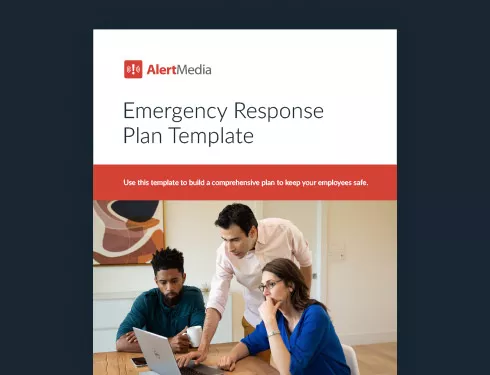
Optimize Your Emergency Response: Team Roles and Responsibilities
Explore emergency response team roles and responsibilities, including structure, delegation, and training for optimal emergency preparedness.

When an organization grows past a certain critical mass, its safety responsibilities quickly outstrip the capacity of a single safety professional. There are simply too many people, systems, locations, and plans that can be protected and maintained by one person alone. That’s why every safety leader must prioritize an emergency response team with clearly defined roles and responsibilities.
Consider Whataburger, the beloved southern quick-service restaurant chain. The business started last century with just a single burger stand but has grown into a sprawling empire of over 900 restaurants across 14 states that all operate 24/7. That’s simply too much for Ron Derrick, Senior Emergency Manager, to handle on his own. But when supported by his small team and their technology-focused Command Center, Whataburger can effectively respond to any emergency, at any of their locations, at any time.
Surprisingly, only 3% of businesses employ a full-time crisis management leader. But that doesn’t mean that the other 97% are doomed in the face of an emergency. Developing and implementing effective roles and responsibilities within an emergency response team is crucial to ensure business safety and continuity. Inadequate planning and structure can significantly impact safety outcomes, hinder response efforts, and compromise the organization’s ability to recover swiftly. Today we’ll delve into the key roles and responsibilities of an emergency response team and provide valuable information for business safety leaders to enhance their incident management capabilities.
Emergency Response Plan Template
The Basics of Emergency Team Building
For the uninitiated, an emergency response team (sometimes known as an ERT or incident response team) acts as the brain that initiates the company’s emergency response plan. These teams are usually small but can vary depending on the organization’s size. They are comprised of representatives from multiple departments, including leadership, facilities, IT, HR, and many others. They’re concerned with crisis mitigation, keeping people safe, ensuring business continuity and disaster recovery, and more. Robust emergency response teams also form a core component of comprehensive disaster management strategies.
Different emergency response roles will be activated depending on the type of emergency. These plans detail who has what responsibilities. The particulars of each plan vary widely and are derived from the specific emergency at hand; a cybersecurity incident response plan won’t call for the exact same people and strategy as, say, an active shooter response plan or a natural disaster evacuation. Once a plan is activated, your team works together to coordinate that response on an organizational level.
Planning Your Emergency Response Team
Establishing an emergency response team requires careful consideration of your organization’s unique needs. Begin by identifying individuals with relevant skills, knowledge, and experience. The team may include representatives from departments such as operations, safety, communications, and medical services. By including diverse perspectives and stakeholders, the team can effectively address various emergency situations.
To determine the team’s size and composition, evaluate the organization’s size, industry, location, and recent business threat assessments to understand the potential risks. Larger organizations might require a larger team, while smaller businesses may have a simplified group.
You’ll then designate team leaders and coordinators to oversee specific areas of responsibility. These leaders will be pivotal in coordinating response efforts and ensuring seamless communication among team members and other stakeholders.
Before you try to make use of your findings, you need to identify what document will act as your information repository. The best option is a purpose-built solution such as an emergency response plan template that can guide your efforts and ensure you include everything you need. There you can list the team roles, contact information, and your actual response plans all in one place
What is a community emergency response team (CERT)?
A community emergency response team (CERT) is a volunteer group trained to assist professional emergency responders during disasters. CERT members help with basic first aid, fire safety, evacuation support, and general disaster response coordination within their communities. While CERTs are community-focused rather than organizationally based, understanding their role can enhance coordination between organizational emergency teams and local volunteer resources during major incidents.
Command-and-Control Structure in Emergency Response
An emergency response team (ERT) is a designated group of trained individuals responsible for managing and coordinating an organization’s or community’s response to various emergency situations. Unlike ad hoc responders, ERT members are specifically selected, trained, and prepared in advance to efficiently handle crises.
A command-and-control structure is an organized framework used by emergency response teams to efficiently manage incidents through clearly defined roles, hierarchical leadership, and structured communication channels. This systematic approach ensures that decision-making is streamlined, information flows effectively, and response actions are coordinated across different teams and external agencies.
Common frameworks guiding this structure include the Incident Command System (ICS), Incident Management System (IMS), and ISO 22320. ICS and IMS are standardized, scalable structures widely used in emergency management to organize resources, personnel, and processes during incidents. Similarly, ISO 22320 provides international guidelines for incident management, emphasizing operational coordination, command-and-control procedures, and communication standards. These frameworks are commonly used in disaster response scenarios, ensuring consistent and effective emergency management practices.
Roles, responsibilities, and communication pathways
Within a command-and-control emergency response team structure, roles and responsibilities are clearly organized, delegated, and coordinated to avoid confusion during crises. At the top is typically the Incident Commander, who holds ultimate decision-making authority. Below them, specific roles—such as operations, logistics, planning, and communications coordinators—are assigned based on expertise, responsibility, and the nature of the incident. Each role has clear responsibilities and communication pathways, ensuring tasks are performed efficiently and effectively.
Establishing a clear chain of command and structured communication is vital. It ensures everyone involved in incident response understands whom to report to, how to escalate critical issues, and how information should flow internally and externally. Structured communication also ensures coordination with external entities, such as local authorities and emergency services, enhancing overall response effectiveness.
A well-implemented command-and-control structure significantly improves incident response by reducing miscommunication, enhancing resource allocation, and enabling smoother collaboration with external partners. Thus, it ensures faster, more effective resolutions to emergencies.
Importance of Preparedness and Team Organization
The primary purpose of an emergency response team extends beyond immediate safety. ERTs protect lives, minimize physical and financial harm, safeguard critical assets, support recovery operations, and uphold overall organizational resilience. Their structured response significantly reduces chaos and confusion during emergencies.
Being prepared and well-organized is essential for effective emergency response. Readiness and structured planning often determine whether an emergency resolves in a controlled manner or descends into chaos.
Preparedness enables emergency response teams to act quickly and confidently during crises. Teams that regularly train and plan can significantly reduce confusion, minimize risks, and better protect people and assets.
A well-organized team clearly understands each member’s roles and responsibilities, streamlining decision-making and action during an emergency. Organized teams communicate more effectively, preventing duplicated efforts or missed critical tasks.
Key steps for achieving preparedness and organization
To achieve effective preparedness and organization, teams should:
- Conduct regular training sessions and emergency drills.
- Assign and clearly communicate roles and responsibilities.
- Develop and maintain up-to-date emergency response plans.
- Continuously review and improve plans based on lessons learned from exercises and real incidents.
Investing time and effort into preparedness and team organization results in safer, faster, and more effective emergency responses, ultimately safeguarding both personnel and assets.
Levels and Functions of Incident Response
Emergency response teams are essential in a wide range of scenarios, including natural disasters like hurricanes and floods, industrial accidents, cybersecurity incidents, active shooter events, and public health emergencies. They operate in diverse environments, from corporate and industrial facilities to community-wide crises.
Incident response is managed at different levels to ensure the response strategy matches the complexity and scope of each specific situation. Tailoring the response allows teams to allocate resources effectively and escalate support appropriately as needed.
Overview of incident response levels
Incident response typically involves multiple levels, each addressing incidents of increasing complexity and resource requirements:
- Level 1: Handled by on-site, initial resources
- Level 2: Managed by the affected organization’s internal resources
- Level 3: Supported by mutual aid from neighboring organizations
- Level 4: Involves broader, jurisdiction-wide mutual assistance
- Level 5: Includes national or international aid coordination
Incident response teams consistently perform core functions at every level, including:
- Command and leadership
- Operations (action and implementation)
- Planning and situational awareness
- Logistics and resource management
- Communication and information management
- Safety and security
- Finance and administration
Scaling functions with incident complexity
The scale and specialization of incident response functions expand as incidents become more complex. Smaller incidents may require only a few primary functions managed by a limited number of personnel. In contrast, larger incidents demand expanded teams, specialized roles, and extensive coordination to effectively address increased logistical, operational, and communication challenges.
Task Delegation and Management
It’s important to distinguish emergency response teams from other emergency personnel, such as first responders, public emergency services, or volunteer groups. Unlike these broader groups, ERTs are pre-assigned and organized specifically within their organization or community, ensuring they understand internal structures, resources, and response plans.
Practical tools and methods for task delegation
To facilitate effective task delegation during emergencies, emergency response teams often use clearly defined processes and practical tools. Digital solutions such as real-time task management software, communication apps, or structured checklists can significantly enhance efficiency. These tools help document assigned tasks, monitor progress, and quickly adjust or reassign responsibilities as the situation develops. Maintaining transparent and accessible task records ensures accountability and reduces the risk of confusion or oversight.
Effective task delegation and management are critical to a successful emergency response. Tasks are assigned and distributed based on clearly defined roles, capabilities, and responsibilities within the team, ensuring optimal resource utilization.
A command-and-control structure supports clear task delegation through hierarchical leadership, defined roles, and established communication channels. This structure ensures that each team member understands their specific duties, who they report to, and how to coordinate their efforts with others.
As incidents evolve, task management processes and protocols must remain flexible and adaptable. Regular updates, briefings, and reviews ensure tasks can be reassigned or adjusted based on emerging needs or changing circumstances. Structured communication protocols play a key role in this flexibility, ensuring clear and timely information flows between responders, decision-makers, and external partners, thus preventing confusion and ensuring accountability.
Coordination within the team and with external partners or agencies is maintained through established protocols, regular status updates, and integrated communication systems. Effective coordination ensures everyone is aligned on objectives and aware of any changes or updates.
Addressing common delegation challenges
Even with structured delegation processes, challenges can arise, including unclear responsibilities, miscommunications, overlapping duties, and difficulties managing volunteers or spontaneous assistance. Emergency Response Teams can proactively address these issues by implementing safeguards such as role-specific task cards, pre-defined delegation checklists, and regular status briefings. These measures ensure clarity, improve communication, and maintain coordination, contributing to smoother incident management.
Strong task management has a significant impact, leading to faster responses, better resource allocation, and improved emergency outcomes. By clearly assigning tasks, maintaining effective communication, and ensuring coordination, emergency response teams can execute their responsibilities swiftly and effectively, enhancing overall incident resolution.
The 7 Most Common Emergency Response Team Roles
The following are some of the most common emergency response team members. Remember that this is not an exhaustive list of possible roles, nor will all of these roles necessarily be included (other than the incident commander).
Be sure to include all contact information for each role so that you always have a way to get in touch with them. Some businesses require specific roles to be available 24/7, in which case you need to designate multiple people for that role and schedule shifts so that they can rotate in and out.
- Incident commander: The incident commander assumes overall leadership and decision-making during emergencies. They coordinate response efforts, delegate tasks, and ensure a cohesive approach. For example, in a fire emergency, the incident commander would assess the situation, direct evacuation efforts, and coordinate with the safety officer and evacuation coordinator.
- Communication coordinator: The communication coordinator manages internal and external communication during emergencies. They liaise with emergency services, stakeholders, and employees, providing updates and instructions. During a crisis, this role ensures effective communication channels are established and information is disseminated in a timely manner, promoting calm and mitigating panic through public relations.
- Safety officer: The safety officer plays a vital role in assessing and mitigating potential hazards. They monitor safety protocols, ensure compliance, and provide guidance on protective measures. In a chemical spill incident, for example, the safety officer would evaluate the extent of the spill, establish safety perimeters, and coordinate with the appropriate authorities.
- Medical first responder: The medical first responder provides immediate assistance and first aid to those who experience a medical emergency. They also coordinate with emergency medical services, ensuring prompt and appropriate medical care. In a workplace injury incident, the medical first responder would assess the injured person’s condition, administer first aid, and coordinate with emergency medical services for further treatment.
- Evacuation coordinator: The evacuation coordinator develops and implements emergency evacuation plans, conducts drills, and provides training for evacuation procedures. During an evacuation scenario, this role ensures orderly and efficient evacuation, accounting for all personnel, including anyone with disabilities, and addressing any possible barriers or challenges.
- Operations manager: The operations manager coordinates logistical support and resources during emergencies. They ensure critical operations continue smoothly and facilitate the resumption of normal business activities. For instance, during a power outage, the operations manager would coordinate backup power supply, prioritize essential operations, and liaise with utility companies to restore power.
- Documentation specialist: The documentation specialist records incident details and maintains documentation related to emergencies. They document lessons learned and conduct an after-action review, aiding in continuous improvement. For example, in the aftermath of a cybersecurity breach, the documentation specialist would record the sequence of events, document the response actions taken, and assist in identifying areas for enhancing cybersecurity measures.
Training and Preparedness for Response Leaders
You can’t afford to discover the shortcomings of your plan only after a crisis is underway. The best way to root out errors before you put your emergency response apparatus into practice is to test and train on these plans so you can ensure familiarity and fix errors.
Conduct regular training sessions for the emergency response team to ensure their skills and knowledge remain up to date. Develop comprehensive action plans and emergency procedures that outline specific roles, communication protocols, and action steps for various scenarios. Simulate emergency scenarios through drills and tabletop exercises to assess the team’s readiness and identify areas for improvement. Regularly review and update emergency response plans based on lessons learned from real emergencies as well.
Ensuring leaders promote a culture of safety
Any emergency plan needs consistency and commitment to work, and the only way to achieve that is through a strong safety culture that supports your emergency response goals. One of the best ways to do this is top-down through leaders who have a large degree of control over your company’s safety culture. As Marcia Kay Thompson said in an episode of The Employee Safety Podcast, “From the Leadership all the way through to the first line employee, they have to understand how they support the culture of safety and, even more so, how what they do plays into that culture.”
Collaboration, Coordination, Communication
No company is an island. Draw on the expertise and support of organizations that have an interest in keeping your people safe. Establish partnerships with external emergency response organizations and local authorities, such as law enforcement and fire departments, to foster collaboration and coordination. Engage in joint exercises and share best practices to enhance collective response capabilities. Set up effective emergency mass notification channels and establish protocols for information sharing and resource coordination.
The Gang’s All Here
While every company is different and has different safety and emergency concerns, they hold one thing in common: Clear and effective emergency response team roles and responsibilities are vital for their business safety and continuity during emergencies. By carefully planning and structuring the team, assigning specific response activities, and providing ongoing training and emergency preparedness, organizations can bolster their response capabilities to new heights.

![11 Steps to Creating an Effective Emergency Response Plan [+ Template]](https://www.alertmedia.com/wp-content/uploads/2023/10/Blog-Emergency-Response-Plan.webp)
![5 Keys to Strong Safety Leadership [+ Company Buy-in]](https://www.alertmedia.com/wp-content/uploads/2022/05/Blog-SafetyCultureBuyIn-Leadership.jpg)

